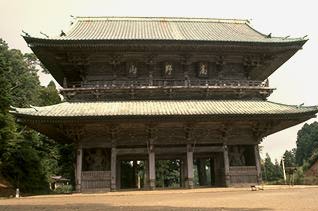
 Go on
to next section.
Go on
to next section.Return to menu page.
The Japanese founder of the Tendai school was Saichō. Not long after he was ordained, he retreated to a small hermitage at Mt. Hiei northeast of present-day Kyoto. His scholarship and skill at lecturing attracted the emperor's attention, and he was selected to join an official mission that departed for China in 804. Having studied Tendai scriptures at Hiei, Saichō proceeded to the head temple of the Chinese Tendai (T'ien Tai) school. He studied there for nine months or so, then returned to Japan with many volumes of Buddhist scriptures. His attempts to establish an autonomous Tendai school--one that did not have to have its monks ordained at Tōdaiji-- succeeded shortly after his death.
The founder of Japanese Shingon was Kūkai, who began his Buddhist career by retreating to the mountains for religious practice. He was sent to China on the same mission as was Saichō. There became the disciple of the Tantric master Hui- kuo, and when he returned to Japan he tried to establish an independent Shingon ordination platform. Like Saichō, Kūkai was unable to accomplish this goal in his lifetime. However, he was permitted to establish a monastery at Mt. Kōya, well to the south of Kyoto and Nara and remote enough--or so it seemed--to be free of venal influence and political control. This was not to be the case, however, and throughout the Heian period, Tendai and Shingon temples competed with each other and with the Nara temples for court favor and donations.

|
 Go on
to next section. Go on
to next section.Return to menu page. |